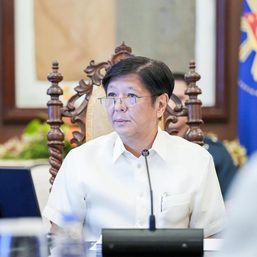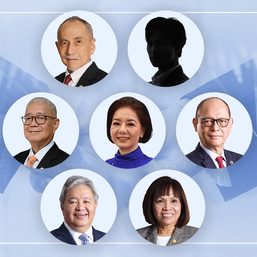SUMMARY
This is AI generated summarization, which may have errors. For context, always refer to the full article.
![[In This Economy] Can the Philippine economy triple in size by 2033?](https://www.rappler.com/tachyon/2024/05/20240531-economy-triple-2033.jpg)
On May 27, the government’s top economic managers led the Philippine Economic Briefing, a forum held at the Philippine International Convention Center (PICC), where the economy’s current state and future prospects were discussed.
Tons of claims were made with varying degrees of realism. Some claims were outright fantastical.
For instance, Finance Secretary Ralph Recto said that our current growth path “puts us firmly on course to become a trillion-dollar economy in less than a decade.” He added: “This means that by 2033, our economy will nearly triple in size, placing us in the league of economic giants like China, Japan, India, and South Korea.”
This is utterly false.
Secretary Recto seems to have gotten his numbers from Rajiv Biswas, Asia-Pacific chief economist of S&P Global Market Intelligence, who wrote a piece in April 2023 (a year ago) making the same claims.
But Biswas was referring to nominal GDP of $1 trillion by 2033, not real (or inflation-adjusted) GDP. He said: “With strong growth forecast over the medium-term outlook, the size of Philippines GDP measured in US Dollar nominal terms is set to reach USD one trillion by 2033.”
Yet in Recto’s graph, the $1 trillion projection was lumped together with real GDP data (in 2023, real GDP was $435.68 billion). Combining nominal and real GDP data in one graph is a rookie mistake. Also, simple math tells you that $1 trillion is just 2.3 times as large as $435.68 billion. Not quite triple.

A little math can also tell us when exactly our economy can triple.
Using a simple mathematical shortcut called “rule of 114,” we can tell that if our economy should triple by 2033 (just nine years from now), total real GDP must grow yearly by 12.67%.
But this is a moonshot. In 2023, the economy grew by just 5.6%, lower than the 6-7% growth target of government (which, in turn, was already lowered from the previous target of 6.5-7.5%).
If we’re already struggling to see at least 6% growth every quarter, how much more difficult is it to reach 12.67%?
Conversely, we can say that if we can grow consistently by 6% yearly (and this is a lot more realistic), our economy will not triple until 19 years later, or by 2043. That’s 10 years more than Recto’s projection. That also falls within the term of the third president after Marcos Jr.
So from multiple angles, it’s plain to see that tripling our economy by 2033 is an impossible dream. Yet Recto’s statement has been unquestioningly repeated by media in tons of news articles and reports. And a lie told a million times, as we know, becomes fact – especially in this country.
Brightest outlook ever?
Other dreamy claims were made by Secretary Recto: that “our economic outlook is the brightest it has ever been,” and that “We have all the makings of a prosperous economy – and we have a bold and decisive leader to fully realize that potential.”
This is quite a stretch!
He showed projected GDP growth all the way up to 2070-2079, and claimed that we’ll become the 14th largest economy in the world by 2075. This is based on numbers from Goldman Sachs.
But I’ve never seen a growth forecast extend so far into the future! There’s a reason established think tanks, like those in the World Bank and IMF, don’t like to make such overstretched forecasts.
Secretary Recto also said that “inflation remains manageable and is expected to settle within the government’s target, lower than global average and developing economies.”
But he omitted to mention that inflation is higher today than it needs to be, thanks to runaway rice prices which President Marcos Jr. hasn’t been able to tame (despite promising P20/kg of rice during his campaign, and despite his stint as concurrent agriculture secretary).
Recto echoed, too, the claim that we’re “expected to ascent [sic] to upper middle-income status in 2025.” But as I wrote before, this has been promised almost yearly since 2017!
He said as well: “The current policy landscape for investments in the Philippines has never been more open and liberalized.” If that is the case, then why even push for (or support) economic charter change?
Recto touted President Marcos Jr. as the country’s “primary marketer” whose “proactive diplomacy has yielded continued inflows of foreign direct investments.”
But in the accompanying graph, it’s clear that foreign direct investments have dropped from 2022 to 2023, notwithstanding all of the Marcosian junkets.
Recto added that Marcos’s “world engagements alone have generated USD72.2 billion-worth of investment pledges as of December 2023.” But the government is thin on data when it comes to the share of those pledges that manifested as actual investments.
Near the tail end of the presentation, Recto said that they still plan to reduce poverty incidence to 14 million Filipinos or about 9% of the population by 2028, or the end of Marcos’ term.
But as of the first half of 2023, more than 25 million were still considered poor. So to achieve their target they must reduce the number of poor people by 2.8 million per year, from 2023 until 2028. That’s another impossible dream.
And how can they do that if Marcos appointed a poverty adviser who very recently claimed that poverty in the Philippines is imaginary (“haka-haka lang”).
I’m not really sure what these economic briefings are for, especially if the economic managers are just going to paint an unrealistic portrait of the Philippine economy and skewer some statistics in the process. The spell of delulunomics continues. – Rappler.com
JC Punongbayan, PhD is an assistant professor at the UP School of Economics and the author of False Nostalgia: The Marcos “Golden Age” Myths and How to Debunk Them. In 2024, he was given The Outstanding Young Men (TOYM) Award for economics. JC’s views are independent of his affiliations. Follow him on Twitter/X (@jcpunongbayan) and Usapang Econ Podcast.
1 comment
How does this make you feel?

![[Rappler’s Best] Fasten seatbelt, Mr. President](https://www.rappler.com/tachyon/2024/07/fasten-seatbelt-mr-president-edit.jpg?resize=257%2C257&crop=235px%2C0px%2C720px%2C720px)

![[OPINION] Power of mimicry: How human rights are covertly undermined in PH](https://www.rappler.com/tachyon/2024/06/duterte-marcos-human-rights.jpg?resize=257%2C257&crop_strategy=attention)
![[Vantage Point] BBM Year 2: Hits and misses](https://www.rappler.com/tachyon/2024/06/thought-leaders-marcos-hits-and-misses.jpg?resize=257%2C257&crop=277px%2C0px%2C720px%2C720px)





![[In This Economy] As new finance chief, will Ralph Recto usher in new taxes (again)?](https://www.rappler.com/tachyon/2024/01/new-finance-chief-ralph-recto-january-12-2024.jpg?resize=257%2C257&crop=372px%2C0px%2C1080px%2C1080px)
![[EDITORIAL] Incomplete? Tigilan na ang humblebrag, Pangulong Marcos](https://www.rappler.com/tachyon/2023/07/animated-bongbong-marcos-second-sona-carousel.jpg?resize=257%2C257&crop_strategy=attention)
Thanks to Prof. JC Punongbayan because without his analysis, we would be fooled by those “outright fantastical claims.” The government spent a lot conducting the Philippine Economic Briefing as part of its disinformation machinery. One of these “outright fantastical claims” is the promise of a “trillion-dollar economy,” as boasted by Finance Secretary Recto. Another claim is that our “bold and decisive leader,” President Marcos Jr., will lead us to this economy. Even if such an economy is achieved, the real beneficiary will be President Marcos Jr’s favored business elite. The rest of the Filipino people, especially the poor among us, will then be convinced to be happy and contented with the “crumbs.”